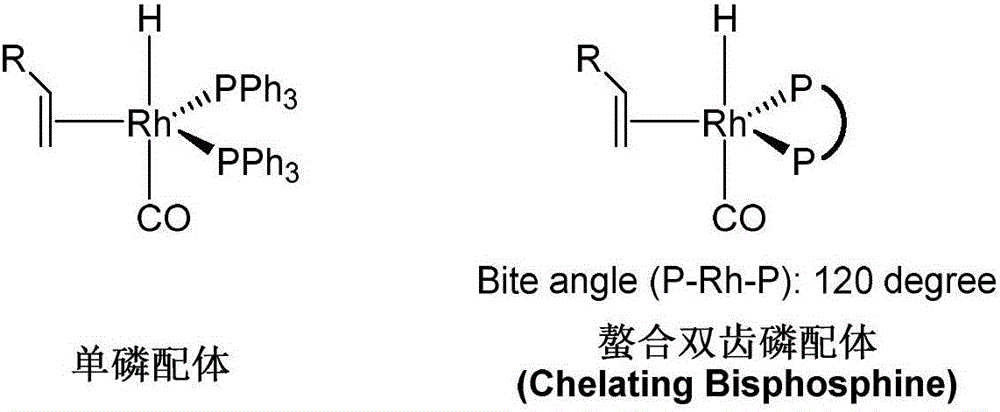Hydroformylation reaction method by using rhodium-ruthenium bimetal and quadridentate phosphine ligand and catalyst
A technology of catalysts and phosphine ligands, applied in physical/chemical process catalysts, catalytic reactions, organic compounds/hydrides/coordination complex catalysts, etc., can solve the problems of low aldehyde product ratio and achieve high conversion rate , high conversion number, and the effect of large industrial application value
- Summary
- Abstract
- Description
- Claims
- Application Information
AI Technical Summary
Problems solved by technology
Method used
Image
Examples
Embodiment 1
[0039] Embodiment 1: adopt rhodium ruthenium bimetallic (Rh(acac)(CO) 2 , RuH(Cl)(PNN)(CO)) and biphenyl triphosphine ligand (Tribi) with rhodium ruthenium bimetallic (Rh(acac)(CO) 2 , RuH(Cl)(PNN)(CO)) and biphenyl tetraphosphine ligand (Tetrabi) isomerization and hydroformylation (S / C=2000, S / C is the molar ratio of reactant to catalyst )
[0040] Rh,Ru+Tribi: Weighing the rhodium catalyst Rh(acac)(CO) in the glove box 2 (5.2mg, 0.02mmol), 2,2', 6-three (diphenylphosphinomethyl)-1,1'-biphenyl (Tribi) (60mg, 0.08mmol) into the complexing bottle, and then remove Oxygen / water dichloromethane (Dichloromethane, 2.65g, 31.2mmol) solvent was placed in the bottle, and stirred to dissolve to form a complex solution of rhodium and biphenyltriphosphine ligand. Subsequently, the ruthenium catalyst RuH(Cl)(PNN)(CO) (9.8mg, 0.02mmol) was weighed in the glove box, added to the complexed rhodium catalyst solution, stirred at room temperature to dissolve it. Put the autoclave into the g...
Embodiment 2
[0045] Embodiment 2: adopt rhodium ruthenium bimetallic (Rh(acac)(CO) 2 , RuH(Cl)(PNN)(CO)) and biphenyl triphosphine ligand (Tribi) with rhodium ruthenium bimetallic (Rh(acac)(CO) 2 , RuH(Cl)(PNN)(CO)) and biphenyl tetraphosphine ligand (Tetrabi) isomerization and hydroformylation (S / C=4000)
[0046] Rh,Ru+Tribi: Weighing the rhodium catalyst Rh(acac)(CO) in the glove box 2 (2.6mg, 0.01mmol), 2,2',6-three (diphenylphosphine methyl)-1,1'-biphenyl (Tribi) (30mg, 0.04mmol) into the complexing bottle, and then remove Oxygen / water dichloromethane (Dichloromethane, 2.65g, 31.2mmol) solvent was placed in the bottle, and stirred to dissolve to form a complex solution of rhodium and biphenyltriphosphine ligand. Subsequently, the ruthenium catalyst RuH(Cl)(PNN)(CO) (4.9 mg, 0.01 mmol) was weighed in the glove box, added to the complexed rhodium catalyst solution, and stirred at room temperature to dissolve it. Put the autoclave into the glove box, pipette 100 μl of complexed rhodiu...
Embodiment 3
[0051] Embodiment 3: adopt rhodium ruthenium bimetallic (Rh(acac)(CO) 2 , RuH(Cl)(PNN)(CO)) and biphenyl triphosphine ligand (Tribi) with rhodium ruthenium bimetallic (Rh(acac)(CO) 2 , RuH(Cl)(PNN)(CO)) and biphenyl tetraphosphine ligand (Tetrabi) isomerization and hydroformylation (S / C=10000)
[0052] Rh,Ru+Tribi: Weighing the rhodium catalyst Rh(acac)(CO) in the glove box 2 (2.6mg, 0.01mmol), 2,2',6-three (diphenylphosphine methyl)-1,1'-biphenyl (Tribi) (30mg, 0.04mmol) into the complexing bottle, and then remove Oxygen / water dichloromethane (Dichloromethane, 6.63g, 78.0mmol) solvent was put into the bottle, and stirred to dissolve to form a complex solution of rhodium and biphenyltriphosphine ligand. Subsequently, the ruthenium catalyst RuH(Cl)(PNN)(CO) (4.9 mg, 0.01 mmol) was weighed in the glove box, added to the complexed rhodium catalyst solution, and stirred at room temperature to dissolve it. Put the autoclave into the glove box, pipette 100 μl of complexed rhodiu...
PUM
 Login to View More
Login to View More Abstract
Description
Claims
Application Information
 Login to View More
Login to View More - R&D
- Intellectual Property
- Life Sciences
- Materials
- Tech Scout
- Unparalleled Data Quality
- Higher Quality Content
- 60% Fewer Hallucinations
Browse by: Latest US Patents, China's latest patents, Technical Efficacy Thesaurus, Application Domain, Technology Topic, Popular Technical Reports.
© 2025 PatSnap. All rights reserved.Legal|Privacy policy|Modern Slavery Act Transparency Statement|Sitemap|About US| Contact US: help@patsnap.com



